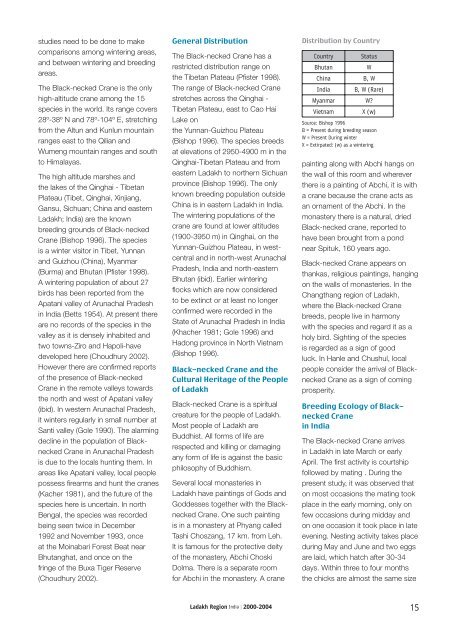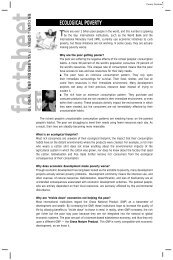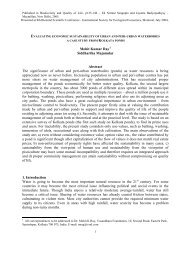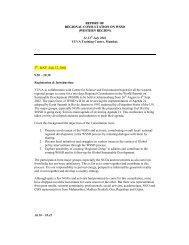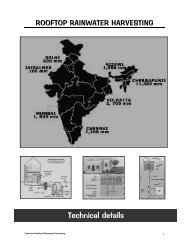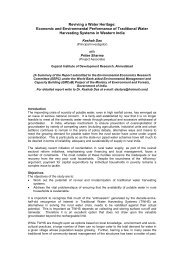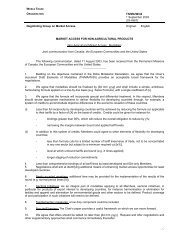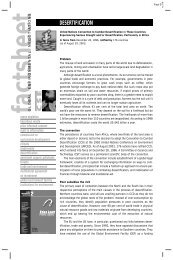Black-necked Crane - WWF-India
Black-necked Crane - WWF-India
Black-necked Crane - WWF-India
You also want an ePaper? Increase the reach of your titles
YUMPU automatically turns print PDFs into web optimized ePapers that Google loves.
studies need to be done to make<br />
comparisons among wintering areas,<br />
and between wintering and breeding<br />
areas.<br />
The <strong>Black</strong>-<strong>necked</strong> <strong>Crane</strong> is the only<br />
high-altitude crane among the 15<br />
species in the world. Its range covers<br />
28º-38º N and 78º-104º E, stretching<br />
from the Altun and Kunlun mountain<br />
ranges east to the Qilian and<br />
Wumeng mountain ranges and south<br />
to Himalayas.<br />
The high altitude marshes and<br />
the lakes of the Qinghai - Tibetan<br />
Plateau (Tibet, Qinghai, Xinjiang,<br />
Gansu, Sichuan; China and eastern<br />
Ladakh; <strong>India</strong>) are the known<br />
breeding grounds of <strong>Black</strong>-<strong>necked</strong><br />
<strong>Crane</strong> (Bishop 1996). The species<br />
is a winter visitor in Tibet, Yunnan<br />
and Guizhou (China), Myanmar<br />
(Burma) and Bhutan (Pfi ster 1998).<br />
A wintering population of about 27<br />
birds has been reported from the<br />
Apatani valley of Arunachal Pradesh<br />
in <strong>India</strong> (Betts 1954). At present there<br />
are no records of the species in the<br />
valley as it is densely inhabited and<br />
two towns-Ziro and Hapoli-have<br />
developed here (Choudhury 2002).<br />
However there are confi rmed reports<br />
of the presence of <strong>Black</strong>-<strong>necked</strong><br />
<strong>Crane</strong> in the remote valleys towards<br />
the north and west of Apatani valley<br />
(ibid). In western Arunachal Pradesh,<br />
it winters regularly in small number at<br />
Santi valley (Gole 1990). The alarming<br />
decline in the population of <strong>Black</strong><strong>necked</strong><br />
<strong>Crane</strong> in Arunachal Pradesh<br />
is due to the locals hunting them. In<br />
areas like Apatani valley, local people<br />
possess fi rearms and hunt the cranes<br />
(Kacher 1981), and the future of the<br />
species here is uncertain. In north<br />
Bengal, the species was recorded<br />
being seen twice in December<br />
1992 and November 1993, once<br />
at the Moinabari Forest Beat near<br />
Bhutanghat, and once on the<br />
fringe of the Buxa Tiger Reserve<br />
(Choudhury 2002).<br />
General Distribution<br />
The <strong>Black</strong>-<strong>necked</strong> <strong>Crane</strong> has a<br />
restricted distribution range on<br />
the Tibetan Plateau (Pfi ster 1998).<br />
The range of <strong>Black</strong>-<strong>necked</strong> <strong>Crane</strong><br />
stretches across the Qinghai -<br />
Tibetan Plateau, east to Cao Hai<br />
Lake on<br />
the Yunnan-Guizhou Plateau<br />
(Bishop 1996). The species breeds<br />
at elevations of 2950-4900 m in the<br />
Qinghai-Tibetan Plateau and from<br />
eastern Ladakh to northern Sichuan<br />
province (Bishop 1996). The only<br />
known breeding population outside<br />
China is in eastern Ladakh in <strong>India</strong>.<br />
The wintering populations of the<br />
crane are found at lower altitudes<br />
(1900-3950 m) in Qinghai, on the<br />
Yunnan-Guizhou Plateau, in westcentral<br />
and in north-west Arunachal<br />
Pradesh, <strong>India</strong> and north-eastern<br />
Bhutan (ibid). Earlier wintering<br />
fl ocks which are now considered<br />
to be extinct or at least no longer<br />
confi rmed were recorded in the<br />
State of Arunachal Pradesh in <strong>India</strong><br />
(Khacher 1981; Gole 1996) and<br />
Hadong province in North Vietnam<br />
(Bishop 1996).<br />
<strong>Black</strong>-<strong>necked</strong> <strong>Crane</strong> and the<br />
Cultural Heritage of the People<br />
of Ladakh<br />
<strong>Black</strong>-<strong>necked</strong> <strong>Crane</strong> is a spiritual<br />
creature for the people of Ladakh.<br />
Most people of Ladakh are<br />
Buddhist. All forms of life are<br />
respected and killing or damaging<br />
any form of life is against the basic<br />
philosophy of Buddhism.<br />
Several local monasteries in<br />
Ladakh have paintings of Gods and<br />
Goddesses together with the <strong>Black</strong><strong>necked</strong><br />
<strong>Crane</strong>. One such painting<br />
is in a monastery at Phyang called<br />
Tashi Choszang, 17 km. from Leh.<br />
It is famous for the protective deity<br />
of the monastery, Abchi Choski<br />
Dolma. There is a separate room<br />
for Abchi in the monastery. A crane<br />
Distribution by Country<br />
Country Status<br />
Bhutan<br />
W<br />
China<br />
B, W<br />
<strong>India</strong> B, W (Rare)<br />
Myanmar W?<br />
Vietnam X (w)<br />
Source: Bishop 1996<br />
B = Present during breeding season<br />
W = Present During winter<br />
X = Extirpated: (w) as a wintering<br />
painting along with Abchi hangs on<br />
the wall of this room and wherever<br />
there is a painting of Abchi, it is with<br />
a crane because the crane acts as<br />
an ornament of the Abchi. In the<br />
monastery there is a natural, dried<br />
<strong>Black</strong>-<strong>necked</strong> crane, reported to<br />
have been brought from a pond<br />
near Spituk, 160 years ago.<br />
<strong>Black</strong>-<strong>necked</strong> <strong>Crane</strong> appears on<br />
thankas, religious paintings, hanging<br />
on the walls of monasteries. In the<br />
Changthang region of Ladakh,<br />
where the <strong>Black</strong>-<strong>necked</strong> <strong>Crane</strong><br />
breeds, people live in harmony<br />
with the species and regard it as a<br />
holy bird. Sighting of the species<br />
is regarded as a sign of good<br />
luck. In Hanle and Chushul, local<br />
people consider the arrival of <strong>Black</strong><strong>necked</strong><br />
<strong>Crane</strong> as a sign of coming<br />
prosperity.<br />
Breeding Ecology of <strong>Black</strong><strong>necked</strong><br />
<strong>Crane</strong><br />
in <strong>India</strong><br />
The <strong>Black</strong>-<strong>necked</strong> <strong>Crane</strong> arrives<br />
in Ladakh in late March or early<br />
April. The fi rst activity is courtship<br />
followed by mating . During the<br />
present study, it was observed that<br />
on most occasions the mating took<br />
place in the early morning, only on<br />
few occasions during midday and<br />
on one occasion it took place in late<br />
evening. Nesting activity takes place<br />
during May and June and two eggs<br />
are laid, which hatch after 30-34<br />
days. Within three to four months<br />
the chicks are almost the same size<br />
Ladakh Region <strong>India</strong> | 2000-2004 15


